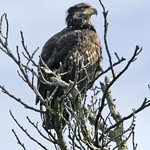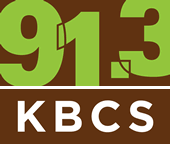Nature – Juvenile Bald Eagle
August 15, 2019 - 11:25 am

Juvenile Bald Eagles are learning to make a living this time of year, while adult eagles feed them. Follow Seward Park Audubon Center’s Lead Naturalist, Ed Dominguez and KBCS’s Yuko Kodama on a trail in Seattle’s Seward Park as they listen for the young eagles’ calls for food.
Producers: Yuko Kodama and Jesse Callahan
Photo: Juvenile Bald Eagle by Rick Leche Photography
Unknown Speaker 0:00
91.3 KBCS music and ideas-listener supported radio from Bellevue College.
Unknown Speaker 0:06
The KBCS’ s listening to nature series, takes you to local parks and beaches to explore the natural neighbors living among us. Join Seward Park Audubon Center’s Lead Naturalist Ed Dominguez and KBCS’s Yuko Kodama as Juvenile Eagles fledg from their nests in Seattle’s Seward Park.
Unknown Speaker 0:22
As you were talking, I heard the Eagles doing the (sounds mimicing eagles) thing. Did you hear it too?
Unknown Speaker 0:27
mm-hmm- These two eagles were hatched late April early May. They’ve been in the nest as youngsters being fed continuously by their parents, and just fledged within the last week. If eagles hatch around the first of May, it takes till mid or late July, before enough feathers grow in on their wings, their primary feathers, as they’re called. And their pectoral muscles become strong enough that they can lift up out of the nest. And so they’ve been kind of lifting off a few inches at a time up in the air for a couple or three weeks now. And now they are able to leave the nest and so they’re hanging out and some tops of some trees like this bleached out white snag we’re looking at, that’s only maybe a quarter of a mile from their nest. They’re waiting for mom and dad to come around and bring them fish. Because even though they can fly, it takes a lot of skill to be able to catch a fish out of the lake. I mean, eagles have great vision, they can be 150 feet in the air and with their eyes see fish down in the water as easily as you and I are looking at one another here on the trail. But to judge the distance down to the water and the fish, to get the right flight speed, to be able to pull up and brake right above the surface of the water and extend their talons at just the right time and get them in the water and successfully nabbed the fish. Well, as you can guess, there’s a lot of misses before they have their first successful catch. So there’ll be dependent on mom and dad to be bringing them fish all summer long. Usually by the time Labor Day rolls around, early September, the adults will stop feeding the eaglets and kind of let them know that it’s time for them to be on their own. And hopefully by that time they’ve developed their hunting skills well enough that they’re able to catch fish and be able to make it through the winter on their own and add to our ever-growing eagle population here in Western Washington.
Unknown Speaker 0:38
And do you get to watch them practice?
Unknown Speaker 2:25
It’s delightful to watch them practice. They come down, wings expanded, talons come out.
(the call of an eagle for food)
I think that means” I’m hungry bring me a fish”, an eagle talk. That’s one of the Juveniles begging for the adult to come in and bring him something to eat. It was just last week, I watched an adult bald eagle one of the parents of these two. And the adult bald eagle saw another fish eating bird called an osprey catch a fish out of the water. And in the bird world. If you can make somebody else give up their fish, you don’t have to worry about catching it yourself. So it was like Snoopy and the Red Baron, a dogfight in the air with the eagle in the ospray turning over one another and flying in tight circles. And finally the eagle got the osprey to drop its fish. The eagle flew down and snatched the fish out of mid-air as it fell down towards the lake and made off towards the nest to feed these youngsters you’re hearing right now. And the poor Osprey had to go back to try to find another meal. So in the bird world, if you can steal someone else’s fish, it’s a lot better than having to fish for yourself.
Unknown Speaker 3:36
And can these birds – they can get back to the nest, okay, right? They’re not just stranded out here until they’re strong enough to go back.
Unknown Speaker 3:45
No, they can get back to the nest easy. In fact, I would say by now they may go back to the nest because it’s been their location for feedings if the adult brings a fish in. But you have to remember that a nest, although we think of it as a place for refuge and nurture. When a bird is in the egg or a bird is very young. A nest is also a target – because all the predators that like to eat eggs or young birds know that there’s a concentrated food supply in that nest. So for all parents, whether it’s Robin’s owls, eagles, any kind of bird, the goal is to get your young out of the nest as soon as possible and disperse. So everybody isn’t all concentrated in one space. So I think these two eagles now that they’re free to be out of the nest will behave like adults, and will just find the evening to perch on a branch of a tree and sleep in the tree -probably in close proximity to one another, these two youngsters. But they won’t be using the nest regularly at all anymore. Also added to that is that, you know the nest, it gets to be a pretty nasty place after several months of these youngsters being fed. So it’s full of fish bones and there can be wing mites.
(the call of an eagle for food)
You know, he wants his dinner.
Unknown Speaker 4:59
These young eagles are they going to stick around Seward Park. Or are they supposed to find their own turf?
Unknown Speaker 5:05
Many times they will stick around. The two young eagles that were fledged last year have still been hanging around and you can see him regularly around the park. So these will probably hang around with their parents and kind of an extended family group all through the winter and into next spring and through probably a lot of next summer. And usually by then they’ll start to move off and be interested in finding their own territory and finding their own mates.
Unknown Speaker 5:32
Hope he gets dinner soon.
Unknown Speaker 5:40
That was Seward Park Audubon Center’s Lead Naturalist Ed Dominguez on the trails of Seward Park for any questions for Ed contact KBCS at news@kbcs.fm.

